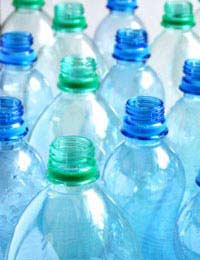What Do the Numbers on Plastic Bottles Mean?

Q.
What exacly does the number mean on the bottom of plastic bottles/containers within the recycling arrows? Is it to do with recycling and sorting or is it the chemicals within the bottle/container? Which ones are harmful and should we avoid using specific numbers especially if they contain food/drink?
A.
In 1988, an international code system for identifying the types of resin used to make many bottles and containers was introduced by the Society of the Plastics Industry (SPI) to boost recycling.
It meant that for the first time, recycling manufacturers in the UK and other countries had a unified code system to work with.
Containers and bottles are marked during manufacture and when they are ready for recycling, the polymer used can be easily identified.
You will find the code on the bottom of many containers in your home and it identifies the material used to make the container. It has nothing to do with the liquid inside the container (although certain resins are more suited to certain contents.)
The Code System
1 - PET
2 - HDPE 3 – V/PVC4 - LDPE 5 - PP 6 - PS 7 - OTHERSo now you probably want to know what each code stands for.
Well …number 1 is PET or PETE and stands for Polyethylene terephthalate which is good at keeping out moisture and is clear and tough.
(There have been internet hoaxes suggesting that PET carries a cancer risk but this is totally unproven. Other studies have found that it contains very low levels of a toxic substance which could leach out but researchers say the evidence is very limited and the levels released are still within USA legal safe amounts.)
All containers or packaging that come into contact with human food or drink must pass strict safety guidelines and as yet, there is no real evidence to suggest that any containers pose a risk to health.
PET is used for a variety of products including plastic soft drinks bottles, beer bottlesand salad dressing bottles.Once recycled, it can be used for clothing, carpet, food and drinks containers and luggage manufacture.
Number 2 - is HDPE (High Density Polyethylene). Known for its resistance to chemicals, it takes shape quickly. It can be found in milk and water containers, shampoo bottles, detergent containers and yoghurt or margarine tubs.
It can be recycled into new shampoo bottles, buckets and flower pots, benches, fencing and picnic tables.
Number 3 – is Polyvinyl Chloride (PVC or vinyl). Flexible vinyl is used in blood bags and medical tubing. It can also be found in window frames, carpet backing and non food packaging.
If recycled, it has many uses including garden hosing, traffic cones and floor mats and tiles.
Number 4 - is LDPE (Low Density Polyethylene) which is transparent,tough and flexible. It is a very good sealant and often used in squeezable bottles, dry cleaning bags and frozen food bags.
Once recycled, it can be used in furniture, floor tiles and rubbish and compost bins.
Number 5 - is Polypropylene (PP). It has good resistance to oil, grease and chemicals and is used for margarine tubs, medicine bottles and yoghurt pots. Once recycled, it is used for a variety of products including bike racks, cases for car batteries and battery cables.
Number 6 – is PS (polystyrene) - an excellent insulator. It is found in aspirin bottles, egg cartons and hot drinks cups. Recycling uses include desk trays, thermometers and rulers.
Number 7 was added to the code system later and is classified as “other.” This means either that none of the resins above were used in the product or that it contains a mixture of them. They can be recycled to make certain bottles and plastic items.


Re: Recycling White Goods
I have my old refrigerator & dishwasher to be given away.
Re: Recycling White Goods
HI I am in need of a spider shaft for my Samsung front loader washing machine. Can anyone help me with one please I am on a disability…
Re: Recycling White Goods
I have an all drink frig and a dishwasher both domestic appliance both working need more space at home
Re: Rules Governing Use of Recycling Logo
I am so confused with recycling labels. Nothing seems standardised? Surely, it should be a case of 2 options Recycle…
Re: How to Recycle Our Office Telephones?
The Parish Council would like to donate the following phone system, if someone could come and collect it. Panasonic…
Re: How to Recycle Our Office Telephones?
We have Phones that we would like to recycle. Poly Phone models CX300 x 20 CX600 x 28 Cx700 x 2 Vvx600 x…
Re: More Environmentally Friendly to Use Glass Milk Bottles?
Why is it more expensive to wash and refill bottles for milk than using a new carton which is…
Re: More Environmentally Friendly to Use Glass Milk Bottles?
I would like to get free range milk in glass bottles, is this possible?
Re: More Environmentally Friendly to Use Glass Milk Bottles?
Do you have recycling experts to talk to? As I am creating new vegan skin care brand and the…
Re: More Environmentally Friendly to Use Glass Milk Bottles?
We have recently started having our milk delivered in glass bottles by a local dairy. At…